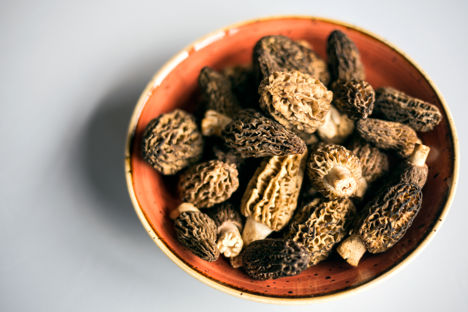Though mushrooms may not come to mind when you think of spring, the prized morel mushroom is for many a foodie the true symbol of seasonal produce. Bearing eclectic aliases around the globe – dryland fish, hickory chickens or molly moochers being just a few – the distinctive honeycomb-surfaced mushroom is a forager’s favourite, and inspires giddy excitement in the most stoic of chefs. The flavour of morels is difficult to describe, but can vaguely be described as nutty, meaty, earthy, rich and fragrant.
The season is brief – April to late May – so make the most of them while you can. Though scattered across the British countryside, be extremely careful if foraging yourself, as there are several poisonous (even deadly) lookalike species, called ‘false morels’.
Morels, like all mushrooms, are best cooked as fresh as possible, but also dehydrate well if you want to preserve that distinctive flavour to enjoy for the rest of the year.
What to look for when buying morels
Due to the fact they have a short season and are difficult to cultivate, morels come with a bit of a price tag, but they are well worth treating yourself to, especially if you’re a big mushroom fan. Choose firm, dry mushrooms; the smaller, younger ones are often a safer bet as they’ve had less time exposed to insects and soggy weather. Due to the many nooks and crannies in the surface of morels, they can be a real haven for grit, dirt and insects, so it’s imperative that you clean them properly.
How to prepare morels
Refrain from washing or soaking morels as you will literally wash away some of their lovely distinctive flavour. Instead, use the corner of a damp cloth or a dry pastry brush to remove any bugs, grit or dirt. Trim the earthy base of the stalk off and slice the mushrooms lengthways. The stalks should be hollow – if they aren’t, get rid of them as they could be a poisonous fake morel. This also gives you chance to get rid of any more hidden dirt. Store in the fridge under a damp cloth – do not suffocate with cling film.
How to cook morels
Morels contain a toxin called hydrazine, which means if you eat them raw they’ll make you ill. Aside from that, they can be treated as you would any other mushroom. Once thoroughly cleaned and prepped, fry in a smoking hot pan with a splash of oil to colour. When the mushrooms are starting to brown, turn down the heat and thrown in a knob of butter, salt and fresh herbs.
Due to their hollow stalks, larger morels are excellent for stuffing. William Drabble stuffs morels with chicken mousse, poaches in chicken stock and serves with seasonal asparagus and golden chicken wings.
Dried morels can be found year round and are easy to prepare. To rehydrate, simply soak in hot water (or stock, or wine) for 15–20 minutes until they have swelled in size and are soft. You also have the added bonus of simultaneously creating an instant, rich mushroom stock (strain through a fine sieve or muslin cloth to remove the inevitable grit). The rehydrated morels are particularly good stirred through a sauce or in a broth.
What morels go with
As with a lot of the finest foods, morels are best cooked simply to showcase their flavour. Sautéed, doused with white wine and cream sauce with lots of fresh herbs and served on toast is a quick and easy way to enjoy them. Traditional mushroom pairings such as beef, bacon and eggs work well. Xavier Boyer’s gorgeous dish of crispy soft-poached egg served with broad bean salad and smoked bacon is a great example.
Pair them with other of springtime favourites such as asparagus, sea trout and lamb. Jersey Royals are a safe bet – Phil Fanning serves them with cured sea trout, nasturtiums and peas, whilst Matthew Tomkinson pairs his with halibut, wild garlic and Jersey Royals for a wonderfully seasonal dish.
Get in touch
Please sign in or register to send a comment to Great British Chefs.



